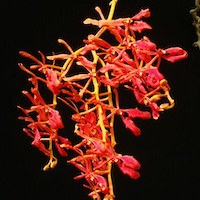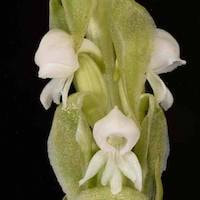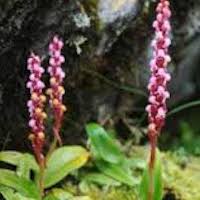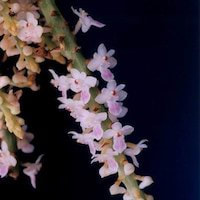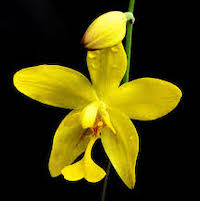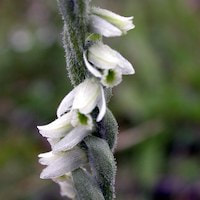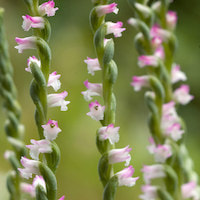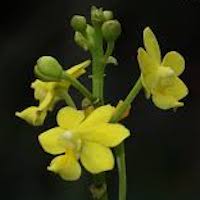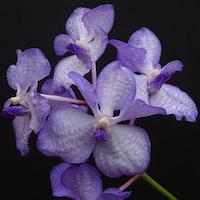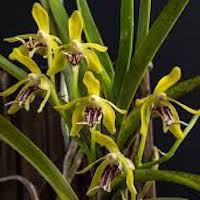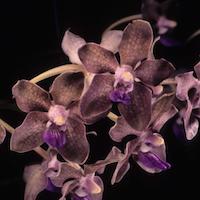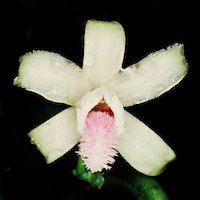|
Renanthera coccinea Lour. Syn. Epidendrum renanthera Raecusch., Gongora phillippica Lianos.
Chinese name and medicinal name: Huoyan lan (fire orchid), red coral It can flower at any time of the year in a hot climate. This popular species is distributed from southern China to Myanmar, Thailand and Indochina. Herbal Usage: In CTM it is used to remove gas, dampness, improve circulation, relieve rheumatic pain and to treat fractures Decoction is prepared with 9–15 g of the plant. The fresh plant is also rendered into a paste for application to affected parts of the body. Pickled young leaves this orchid (Indonesian names: Anggrek Merah, Boenga karang) was considered a delicacy. Phytochemistry: Alkaloid is present in trace amounts (approximately 0.001 % dry weight, but the levels are much higher when dried. They exceed 0.1 % dry weight. |
|
Rhynchostylis retusa (L.) Blume
Common names: Fox Tail Orchid Chinese name: Zuanhui Lan (drill beak orchid) Indian names: Dronpadi Mala in Hindi, Seetechi veni (Gajaara), Panas koli (Konkani), Pumam (Orissa), Rasna (Arunachal Pradesh), Banda, Rasna (Uttarakahnd) Bangladeshi names: Sita pushpa, Pumam, Parada mura Thai name: Alyaret, Hang Kraro Indonesian name: Angkrek Lilin in Sundanese and Malay (candle orchid) Nepalese names: Ghoge gava, Thur in Nepali, Gam (Gurung) Chadephuul It is a stout, tough, prolific epiphyte which thrives in deciduous and dry evergreen forests. Plant grows well but does not flower if it does not have a dry period. It has a wide distribution from Sri Lanka and India across Myanmar, south China, Thailand, Indochina and Malaysia to the Philippines. In Peninsular Malaysia, it occurs only in the northern states of Kelantan, Perlis, Kedah and Perak. It is common at low elevations in the Western Ghats. Phytochemistry: A small amount of alkaloid (between 0.001 and 0.01 % dry weight) Herbal Usage: In India, the fresh plant is used as an emollient. Leaves are used to treat rheumatism. Root of Pumam (R. retusa) mixed with leafy shoots of Pisum sativum (pea) is made into a paste which forms a remedy for bloody diarrhea among the primitive Dongria Kandha tribe of Orissa. A paste made with the leaves is used for wounds. Leaves are used to treat rheumatic disorders in Uttarakhand. Roots (known locally as Rasna in Arunachal Pradesh) are used in a similar manner. Plant is used to manage asthma, tuberculosis, nervous twitching, cramps, infantile epilepsy, vertigo, palpitations, kidney stones and menstrual disorders. |
|
Robiquetia succisa (Lindl.) Seidenf. and Garay
Chinese name: Jishu lan. In Hong Kong: preci- pice orchid, big ladder orchid Chinese medicinal name: Xiaoyejishu Lan Thai name: Uang Man Pu Flowering period is May to August in Thailand and northeast India. It flowers from June to September in China. It is found open forests and on cliffs at 500–1200 m in India and Bhutan across Myanmar and Thailand to Laos and Vietnam, and China. Phytochemistry: Alkaloid is present in small amounts. Herbal Usage: The whole plant is used as a blood tonic. In CTM, it is used to treat “heaty coughs”; it soothes the lungs. |
|
Satyrium nepalense var. ciliatum (Lindl.) Hook. f.
Chinese and medicinal name: Yuanmaoniaozu Lan (hair edged bird feet orchid) Flowers are pink and flowering period is August to October in China. Herbal Usage: Stem is used to strengthen the loins, invigorate the kidney, nourish blood and calm the mind. It is used to treat nephritis, weak kidneys and backache, swellings of the face and legs, and heart disease. |
|
Satyrium nepalense D. Don var. nepalense
Chinese name: Dui dui shen Chinese medicinal name: Niaozu lan (bird feet orchid), Dui dui shen Indian name: Ezhtkwehhdr in aboriginal Toda (bullock’s horns) referring to twin spurs of flower; salam misri Nepalese names: Mishri, Thamni It is a common, highly variable plant found at 1300–3200 m in Myanmar, Sikkim, Nepal, Bhutan, west Yunnan, and in Pakistan. The generic name uses the Greek word satyr to highlight the previously popular use of this orchid as an aphrodisiac. Herb is harvested in autumn and sun-dried. Herbal Usage: Tubers are eaten by the Monpa tribe to treat malaria, dysentery and as an aphrodisiac. They are regarded as a tonic. Tribal people at the Kudremukh National Park use tubers to treat malaria and dysentery. Dried tubers are consumed as a tonic or prophylaxis against dysentery, whereas juice is taken for fever and used on cuts and wounds. In Yunnan, it is used to treat low backache, chronic nephritis, and weak kidneys and erectile dysfunction. |
|
Sedirea subparishii (Z.H. Tsi) Christianson syn. Hygrochilus subparishii Z.H. Tsi
Chinese name: Duanjingeji Lan Chinese medicinal name: Zhijialan Fragrant Orchid: This has a nice sweetish scent. Herbal Usage: In CTM is used to counter heat and wind. A decoction prepared with 30 g of the herb, sweetened with white sugar, is administered to children afflicted by acute illnesses involving the brain and nerves. |
|
Smitinandia micrantha (Lindl.) Holtt.
Chinese name: Gai hou lan Thai names: Khem Nu (in Bangkok), Kulap dong (in Ubon Ratchathani) It flowers in May to July in Nepal, April in China, almost year-round in Thailand and April to May in Perlis in northern Peninsular Malaysia. Herbal Usage: In Nepal, powdered plant is mixed with rice flour and butter, then baked, and served as tonic. Leaves are used to treat rheumatism, and juice extracted from the roots is used to treat cuts and wounds. |
|
Spathoglottis affinis de Vriese Syn. Spathoglottis lobii Rchb.f.
Thai names: Tan diao (in the north), Khao niao Hua khao nieo (in Prachin Buri), Luang Phitsamon (in general); also Luang Si Sa Ket This small, yellow Spathoglottis distributed in Burma, Thailand, Peninsular Malaysia and Java. In Malaysia, it is found only in Gunong Jerai in the north, and even there it is now quite rare. Herbal Usage: Pseudobulbs are used to treat abscesses in Thailand. In Indochina, it was used to heal war wounds and infected wounds. |
|
Spathoglottis plicata Blume
Common names: Pink Spathoglottis; Purple Spathoglottis Chinese name: Zihuabaoshe Lan Malay names: Lumbah tikus (little mouse); (in aboriginal Sakai): Wah Indonesian names: Angkrek Daun Tjongkok; Angkrek Tjongkok (in the Sunda islands), Antel-antelan, Djangkuawang (Java), Kupur (Gajo), Buluh Hutan (Menado), Daun korakora, Daun tana, (Maluku), Ahaan (Amboin) Lalagu (Halmahera), Kusuma raka (Ternate), Bure (Seram utara) Thai names: Krathiam pa, Wan chuk (in Trat), Sapato, Ueang din (in Bangkok) It flowers throughout the year, with peaks after the change of monsoons, or during the dry seasons. Mr. Issac Henry Burkill (1870–1965), Director of the Singapore Botanic Gardens from 1912 to 1925, had them planted at Malaysian-Singaporean gardens. In Singapore, it is found in open scrubland or belukar in the company of Aurndina graminifolia, Nephentes species, grasses and ferns. Herbal Usage: In the state of Perak in Peninsular Malaysia, aboriginal tribes used a decoction as a foment to treat rheumatism. A decoction of the plant is used to treat rheumatism and as a hot foment in India. It is also used to treat rheumatism in Bangladesh. In the Nicobar Islands, it is used to treat earache. A yellow salve made from its powdery seeds is sometimes applied on children in place of bedak (jasmine-perfumed rice flower) to promote a fair countenance. |
|
Spathoglottis pubescens Lindl.
Chinese names: Baoshe Lan (bud tongue orchid), Huanghuaxiaodusuan (yellow flower small single garlic), Chinese medicinal name: Huanghuadusuan (yel- low flower single garlic) Thai names: Toe si re kho (Karen and Mae Hong Son), Ban Chuan (Mae Hong Son), Ueang din (Lampang), Ueang din lao (in Chiang Mai), Ueang nuan chan (in the north) The Chinese herb comes from the region south of the Yangzi. It wass one of the earliest colonisers of Krakatoa after the place was shattered and minimized by a massive volcanic eruption in 1883. Even now, the seeds germinate readily when sown around the parent plant. Despite this apparent robustness, it is extremely prone to virus, and it is used as an indicator plant to identify the presence of virus in other plants. Herbal Usage: The stem is said to benefit the lungs. It stops coughs, promotes granulation, and heals sores . To prepare a decoction 9 g is used. The fresh herb is used in the preparation of a poultice. |
|
Spiranthes sinensis (Pers.) Ames Syn. Spiranthes sinensis (Pers.) Ames var.
amoena (M. Bierberson) Hara Chinese names: Shoucao (tassel grass), Qinglongchanzhu, Jinlongpanshu, Panlongshen, Longbaozhu, (dragon coiled around a post); Qingmingcao (bright spring herb) Taiwanese name: Chheng-thian-lion-thiau Japanese name: Nejibana (spiral flower), Nezibana, Mojizuri Korean name: Ta-rae-nan-cho Mongolian name: Aolangheibu. Vietnamese name: Ban long sam Medicinal names: Panlongshen in Chinese; Poon lung sum (Hong Kong); Chheng thian liong thiau (Taiwan); Bamryongsam (Korean) Indonesian names: Angkrek hindesan, Djukut hindesan (Sundanese) (wool-comb orchid) It is a small terrestrial orchid which grows almost as a weed in lowland fields, meadows and forests in both acidic and alkaline soils. It thrives even in disturbed areas and is to be found along roadside drains in Brisbane, preferring a moist to a dry environment. After flowering, the plant enjoys a growth period of several months. Then it dies back to the bulb. Individual plants live for only 7 or 8 years, but they produce clusters of little bulbs before they die. Phytochemistry: Chemicals found- Spiranthols A and B, spirasineol A, orchinol, p-hydroxybesaldehyde, p-hydroxybenzyl alcohol, hydrocarbons, sterols and ferulates. Spiranthol A showed cytotoxic activity on HeLa-S3 cells, with inhibition rates of 98.77 % at 25 mcg/ml and 7.03 % at 6.26 mcg/ml. The 9,10- dihydrophenanthrene derivatives showed bacteriostatic activity on Gram-positive bacteria. Dihydroflavanoid isolated from CTM medicine, constituted from the roots, inhibited cell growth in the human tumour cell lines A549, BEL-7402, SGC-79001, MCF-7, HT-29, K562 and A498 in vitro. Herbal Usage: In CTM, the whole plant is decocted with pork and used to strengthen the “kidneys” and “to cure spitting of blood”. A similar preparation is used by the Bai minority in western Yunnan to treat kidney inflammation or to strengthen the kidneys. Plants are sun-dried for storage. It nourishes and strengthens a weakened body. It is a folk remedy in Taiwan for haemoptysis, epistaxis, headache, chronic dysentery and Meningitis. |
|
Taprobanea spathulata (L.) Christenson. Syn. Vanda spathulata (L.) Spreng
Indian name: Ponnamponmaraiva in the Malaya- lam dialect Herbal Usage: It is used to treat diseases involving the nerves, rheumatism and scorpion stings. Juice from the plant are used “to temper bile and abate frenzy”. Powder prepared from dried flowers were used to treat asthma and mania. Crushed leaves and stems are made into an ointment for treating various skin lesions. It is one of the “Indigenous Drugs of India” |
|
Thrixspermum centipeda Lour.
Thai name: Kratai hu dieo, Ta khap lueang, Tin ta khap, Ueang maeng mumkhao It is an epiphytic species that flowers in June to July in China; July to September in Thailand. It is widely distributed from Bhutan to Hong Kong and Indonesia. Usage: Whole plant is used to treat asthma in Thailand. |
|
Thrixspermum pardale (Ridl.) Schlecht. Also Sacrochilus pardalis, Ridl., Dendrocolla pardalis (Ridl) Ridl.
It is distributed in Sumatra, Peninsular Malaysia and Borneo, in the first locality at 1000 m. In Peninsular Malaysia, it was regularly found on trees in Perak and Pahang. Herbal Usage: Leaves made into a paste for treating nose ulcers. Fragrant Orchid: Flowers smell of European Meadowsweet. Main components of the strong scent are- cis-linalool oxide and nerolidol overlaid with (E,Z)-2,4-decadienal, ethyl(Z)-4-decenoate, ethyl (E,Z)-2,4-decadienoate with the corresponding (E,E)-isomers and gamma-decalactone. The typical aroma of Bartlett pears is produced by ethyl (E,Z)-2,4-decadienoate and the corresponding methyl ester. |
|
Thunia alba (Lindl.) Rchb. f. Thunia marshalliana Rchb. f., Phaius albus Lindl.; P. marshallianus Rchb.f.; N.E. Brown
Chinese name: Sun Lan (bamboo orchid) Chinese medicinal names: Yan Sun (rock bamboo); Yanjiao (rock horn); Shizhuzi (stone bamboo) Jiegudan (fracture union pill); Shisun (rock bamboo); Yanzhu (rock bamboo) Thai names: Chang Nga Dieo (in general), Phothuki (in Karen Mae Hong Son), Sawet sot si (in Bangkok), Ueang nga chang (in Chiang Mai) Nepalese names: Goliano It flowers in June in China and from March to August, in Bhutan, Darjeeling and Sikkim. It is usually lithophytic, sometimes found in the hollows of large branches of trees growing in rocky soil. It has a wide distribution from India, through Nepal, Bhutan, Myanmar, eastern Tibet, southwest Sichuan and southern Yunnan to Thailand and Malaysia. Herbal Usage: Herb is collected throughout the year. It is used fresh. For storage, it is first boiled, then dried. Chinese herbalists use the whole plant to enrich yin, benefit the lungs, clear phlegm and stop coughs, improve blood flow, remove bruises and assist the healing of fractures. It supposedly dissolves extravasated blood and improves circulation. In Nepal, its paste is used to help set fractures. |
|
Tropidia curculigoides Lindl. Syn. Tropidia graminea Bl.; T. formosana Rolfe;
Schoenmorphus capitatus Gagne. Chinese name: Duansuizhujing Lan. In Hong Kong: bamboo stemmed orchid Malay names: Serugut, Ranchang hantu Description: This is a very unusual terrestrial orchid which has the appearance of bamboo but with large, lanceolate, plicate leaves, which are widely spaced along the erect stem. It is distributed from India, Bhutan and Bangladesh across Southeast Asia to southern China, Taiwan, Australia and Fiji. In Bhutan, it flowers in May. In China from June to August and in northeast India, November. Usage: A decoction of the plant is used to treat malaria and decoction of the roots is used for diarrhea in Peninsular Malaysia and India. It has a similar usage in Bangladesh. There is no medicinal usage for this Orchid in China, but in India this is used for treating several common diseases. |
|
Vanda coerulea Griff. ex Lindl.
Chinese name: Dahuawandai Lan (big flower ten thousand generation orchid, Large Vanda) Thai name: Fa Mui (in the north), Pho don ya, Pho thong (Karen Mae Hong Son) Myanmar Name: Moe lone hmine Indian name (Tirap District, Arunachal Pradesh): Rangpu It forms the backbone of most blue and red Vanda hybrids. Hence, it was highly sought after and over collected. It was declared an endangered epiphytic species. Due to protection provided, it is now thriving in the wild, especially in Myanmar and northern Thailand. In Arunachal Pradesh, it is venerated and used for worship. Phytochemistry: Phytosterols, terpenoids, carbohydrates and stilbenoids were identified. Imbricatin, methoxycoelonin and gigantol showed anti-oxidant properties and inhibited COX-2 production and activity in ultraviolet-irradiated skin cells, thus suggesting that they could protect skin against the harmful effects of sunlight and pollution. Herbal Usage: Juice from the leaves is used to treat dysentery and diarrhea. Juice is also used for skin diseases. It is also reported to be used extensively for lesions of eye in northeastern India. |
|
Vanda concolor Blume
Chinese medicinal name: Qinchunwandai Lan Thai name: Khao kae (in Bangkok) It flowers in April and May and is found only in Guangxi, southwest Guizhou, southern Yunnan and Vietnam. Herbal Usage: CTM states that it detoxifies and removes dampness. It is used to treat peripheral neuritis and ulcerative swellings such as carbuncles. |
|
Vanda cristata Wall ex Lindl. Syn. Trudelia cristata (Wall ex Lindl.) Senghas
Chinese name: Chachunwandai Lan Nepali name: Bhyagute phul in Nepali dialect, Vashgute phul Myanmar name: Jyo koke thitkhwa This is a common, epiphytic, vandaceous orchid, distributed in Nepal, Bhutan, northern India, Tibet and southwest Yunnan. In Bhutan and northeast India, it commonly occurs on the trunks of Rhododendron arboretum and Skimmia spp. Phytochemistry: The 1-hydroxymethylpyrrolizidine ester, laburnine acetate was isolated. Laburnine is a poisonous alkaloid originally isolated from unripe seeds of Laburnum anagyroides. It possesses antimicrobial activity against fungi and Shigella. Herbal Usage: Plant is made into a paste to treat cuts and wounds in India. In Nepal, a paste made with the roots is used for treating boils and dislocated bones. Leaf powder is used as an expectorant, whereas leaf paste is applied on cuts and wound. Leaves are also used to make a tonic and expectorant in NW India. It is used as a nutrient and tonic for general debility in Uttar Pradesh. |
|
Vanda tessellata (Roxb.) Hook. ex G. Don Vanda roxburghii R. Br.
Sri Lankan names: Anuradhapura Orchid, Grey Orchid, Rat-tha, Arattha, Rasni Indian names: Naguli (Tamil), Banki (Orissa), Nai (Bengal), Bandanike (Canaarese), Banda, Nai, Perasara, Persara, Vanda, San, Alisara (Hindi), Atirasa, Bhujangakshi, Chhatraki, Dronagandhika, Elaparni, Gandhanakuli, Muktarasa, Nakuleshta, Nakuli, Palankapa, Rasadhya, Rasana, Rasya, Sarpagandha, Shreyasi, Suggandha, Sugandhimula, Surasa, Suvaha, Vandaka, Vriksharuha, Yuktarasa (Sanskrit), Darebanki (Santal), Chittiveduri, Kanapabadanika, Mardaru, Vadanika (Tel- ugu), Banda (Urdu), Knapachettu (Madras Presidency in 1933), Jarakindu, Japa (Madhya Pradesh), Ippa vajrnika (Gonds of Andra Pradesh), Vandekigidda (Karnataka), Maravazha (Kerala) Indian medicinal names: Rasna in Sanskrit, Hindi, Marathi, Bengal and Mumbai. However, Rasna refers more commonly to Pluchea lanceolata which is not an orchid. Rasha (Unani) Nepalese names: Parajiva, Rasna Arabic name: Kharkittan Persian name: Zanjabeel-e-shami Thai name: Ueang sam poi India (in Chiang Mai), Ueang suea lek (in Bangkok) It is a robust, lowland, epiphytic orchid. It occurs in Sri Lanka, India, Nepal, and Myanmar close to human habitation. It has a wide tolerance for sunlight, (27–93 % sunlight), high temperatures (26–31 oC) and low relative humidity (31–44 %). Phytochemistry: It contains alkaloids, tannins, resin, saponin, beta and gamma sitosterols, fatty oil and colouring agents. An extract of the entire plant produced an anti-acetylcholine and anti-arthritic effect on rats. It contains two anti-inflammatory compounds, hepcosame (C27 H56) and octacosonol (C28 H58 O). Tessallatin, a phenanthropyran, was isolated from V. tessallata. Herbal Usage: This orchid medication is mentioned by ancient Sanskrit writers under the names Rasna (or Raasnaa- the ancient “anti-ageing” tonic and Gandhanakul) which are said to be bitter, aromatic and useful for rheumatism. Rasna was used to treat nervous disorders, rheu- matism and scorpion stings. It was a popular prescription for rheumatism. A liquid extract or syrup prepared from the orchid was used to treat dyspeptic conditions, bronchial affections and rheumatic fever in India. Ear drops are prepared from the roots. The whole plant is used to treat fractures, and roots as a female contraceptive. Leaves are thought to be capable of preventing wounds from developing into purulent sores. Leaves are also used to treat tearing and earache, the latter either by itself or in combination with the aerial roots and neem oil. It was used by herbalists to treat secondary syphilis and for snake and scorpion bites. The Dongria Kandha tribe of the Niyamgiri Hills of southwest Orissa uses a decoction of the root in honey for the treatment of STDs (sexually transmitted diseases. Fragrant Orchid: strong floral scent of V. tessellata is because of linalool (23 %), methyl benzoate (61.5 %), cinnamic aldehyde (%.1 %) and methyl cinnamate (4.6 %). It has lot of traces molecules, such as benzyl acetate, alpha-ionone, 3-phenylpropanal, p-cresol and indole. Fragrance of V. tessellata is transmitted to its F1 and F2 progeny in hybrids made with other species of Vanda. Roots of V. tessellata are also fragrant. |
|
Vanda testacea (Lindl.) Rchb.f. Syn. Vanda parviflora Lindl.
Indian name: Malanga in Orissa. Medicinal names: Rasna, Banda Thai name: Khem lueang (in Bangkok) It is found at the foothills on of the Himalayas, in Nepal, Bhutan and Sikkim, extending to northern Myanmar, Thailand and Sri Lanka at 800–2000 m, in dry, broad-leaved forests. In Bhutan and Sikkim, it occurs in broad-leaved forests, commonly on Terminalia chebula. Phytochemistry: Parviflorin and tessalatin, two 9,10-phenanthropyran derivatives were isolated from whole plants. Herbal Usage: The orchid is used to treat rheumatism. Crushed leaves are applied to cuts and wounds. Its decoction is used for earache. An Orissa hill tribe uses the plant to treat earache. Root is boiled to prepare a decoction that is taken twice daily to cure asthma. The roots are used to treat dyspepsia, bronchitis, inflammation and coughs under the Unani system. They are also used to tone up the liver and brain, reduce inflammation and heal minor fractures and are sold as rasna in Ayurvedic shops. |
|
Vanilla aphylla Blume
Thai Name: Khot nok kut (in Surat Thani), Khruea ngu khieo (in Nakhon Ratchasima), Thau ngu khieo (in Saraburi) Description: Stems are a dark green and flattened. It is distributed in the southern half of Thailand, Myanmar, Indochina, northern Pen- insular Malaysia and Java. Herbal Usage: The stem is used in the treatment of liver dysfunction in Thailand. |
|
Vanilla griffithii Rchb. f.
Indian name: Telinga kerbaoo It is distributed in India, southern Thailand, Sumatra, Peninsular Malaysia and Borneo at low elevations, rooting in the ground and climbing trees in shady locations. Herbal Usage: The large fruit is sweet and edible, tasting like small bananas. It is eaten as a vegetable in India. An aqueous extract of its flowers is applied on the body to treat fever. Juice from the leaves is applied on the hair to encourage thick growth. In Indonesia, the milky sap of the stems is used as a hair-promoting shampoo. |
|
Vanilla planifolia Jacks. ex Andrews
Thai names: Wanila (in Bangkok), Vanilla It was introduced into cultivation in the French Reunion Island from Central America in 1817 by way of Mauritius because of the high content of vanillin in its large, fleshy seedpods which have a length of up to 15 cm. Today, vanilla comes from many sources which include Central America, Mauritius, Reunion, Madagascar, Indonesia, the Pacific Islands, India (northeast India, Kerala, Karnataka, Tamil Naidu and Lakshadweep), the Andaman and Nicobar Islands, Thailand, Indochina and China. In its native Central America, it grows in damp forests up to 600 m. They are hand-pollinated in the Vanilla farms. The exported products are the vanilla pods which are variable in quality and contents from source to source as well as from batch to batch. Fragrant Orchid: The major fragrance in vanilla pods is vanillin which accounts for about 2 % of the fermented fruit (range 1. 5–2.75 depending on provenance. However, vanillin is not present in newly harvested pods. It is formed during curing or fermentation when the precursor, non-volatile compound vanilloside (gluco-vanillin) undergoes beta-hydrolysis. Vanillin accounts for around 85 % of the volatile compounds. Another is p-hydroxybenzaldeyde (9 %), with p-hydroxybenzyl methyl ether accounting for 1 % Phytochemistry: About 130 compounds have been isolated from natural vanilla. These are made up of phenols, phenol ethers, alcohols, carbonyl compounds acids, esters, lactones, aliphatic and aromatic carbon hydrates and heterocyclic compounds. Herbal Usage: The whole plant is considered to have aphrodisiac value in India. The roots are used as a stimulant and to treat gonorrhea and dysuria, possibly resulting from the sexually transmitted disease. |
|
Zeuxine strateumatica (L.) Schltr.
Chinese name: Xianzhu Lan Taiwanese name: Cao Pu Lan (bunched grass orchid) Indian name: Shwethuli in Bengal Nepalese name: Kansjhar Bangladeshi name: Swet huli, Shwet huli This is the most widely distributed species occurring abundantly in grassy locations in moist, swampy ground, even in running water, throughout India from the lowlands. It is almost a weed of some padi at low elevations in Malaysia and Indonesia. Herbal Usage: Tubers are used as Salep. They are considered to be a blood purifier and tonic, it is used externally for boils. It is also used to treat infections of the eye. It is still used as a tonic, or as a form of Salep, in Bangladesh. |
Join Scentopia's wonderful orchid scent crafting, fragrance tour, bridal shower or corporate team building which includes perfume making onsite and offsite, beach activities and more. We also serve primary school learning journey, secondary students and pupil on industrial excursions. Know more about our orchids perfume bar or therapeutic orchid scents and other wellness aromas. Conatct Perfume workshop or book a scent crafting session here.
